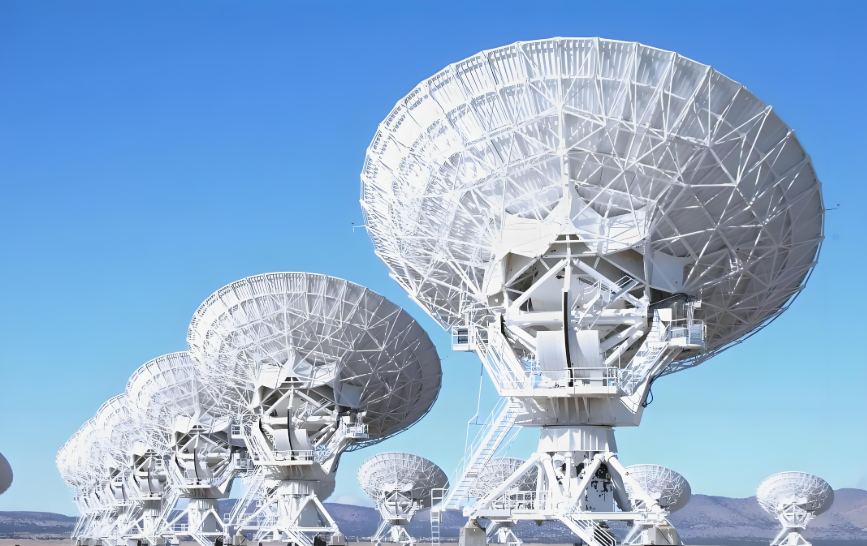1. What Is Radar?
Radar (Radio Detection and Ranging) is an electronic sensing system that uses radio waves to detect and determine the position, velocity, and characteristics of objects.
The core process follows a simple logic: transmit electromagnetic waves → receive reflections → analyze and calculate.
By measuring the time delay between transmission and return, a radar determines distance.
By analyzing frequency shifts (Doppler effect), it calculates target velocity.
By comparing phase and angle differences, it estimates direction and elevation.
2. Components of a Radar System
A complete radar system typically consists of:
- Transmitter – Generates high-frequency electromagnetic pulses
- Antenna System – Directs and receives radio signals, controlling beam orientation
- Receiver – Captures and amplifies returned echoes
- Signal Processor – Filters noise, detects targets, and computes range and speed
- Display & Control Module – Visualizes spatial data and enables operator control
Modern radar systems also integrate Digital Signal Processing (DSP) and Software-Defined Radar (SDR) modules,
enabling flexible waveform control, automatic calibration, and adaptive signal optimization.
3. Major Types of Radar
1. Pulse Radar
Transmits short bursts of electromagnetic energy and measures echo time to determine range and azimuth.
It offers long detection range and high resolution, making it essential for air defense and coastal surveillance.
2. Doppler Radar
Uses frequency shifts to measure velocity and distinguish moving targets from stationary clutter.
Widely applied in drone detection, weather observation, and traffic speed monitoring.
3. Continuous Wave (CW) Radar
Emits a constant signal instead of pulses.
Ideal for velocity measurement and target tracking, though it cannot measure distance directly.
4. Synthetic Aperture Radar (SAR)
Generates high-resolution ground images by using antenna motion to simulate a large aperture.
Commonly used for terrain mapping, remote sensing, and environmental monitoring.
5. Phased Array Radar
Electronically steers its beam without mechanical movement, enabling rapid scanning, multi-target tracking,
and wide-area coverage — a core technology in modern air defense and surveillance systems.
6. Microwave / Millimeter-Wave Radar
Operates at very high frequencies, providing high-resolution detection and fine target discrimination.
Common in autonomous vehicles, anti-collision systems, UAV navigation, and industrial inspection.
4. Signal Processing and Workflow
From transmission to target detection, the radar workflow follows:
- Transmission – The system emits electromagnetic pulses
- Echo Reception – The antenna captures reflections from targets
- Amplification & Filtering – Noise suppression and signal enhancement
- Echo Analysis – Distance, velocity, and direction computation
- Display Output – Generates 2D or 3D situational awareness maps
Modern systems rely on pulse compression, digital beamforming (DBF), and constant false alarm rate (CFAR) algorithms
to enhance detection precision, improve anti-jamming capability, and ensure reliable target recognition.
5. Application Fields
| Domain | Description |
|---|---|
| Defense & Security | Air defense, border surveillance, and counter-UAV systems. |
| Maritime & Ports | Ship monitoring, channel management, and intrusion detection. |
| Aviation & Aerospace | Flight navigation, obstacle avoidance, and satellite imaging. |
| Meteorology | Rainfall tracking, storm analysis, and wind pattern observation. |
| Transportation & Autonomous Driving | Vehicle collision avoidance, adaptive cruise, and environment perception. |
| Industry & Research | Geological exploration, structural monitoring, and non-contact inspection. |
6. Future Technology Trends
AI Integration
Artificial intelligence enables automatic classification, recognition, and real-time decision support.Networked and Cooperative Radar Systems
Multi-node radar networks enable cross-domain sensing and shared situational awareness.Miniaturization and Low-Power Design
Compact radar modules are increasingly embedded in UAVs, robots, and vehicles.Multi-Sensor Fusion
Combining radar with optical, acoustic, and infrared sensors ensures all-weather coverage.Software-Defined Radar (SDR)
Software-based configuration of radar parameters allows adaptive performance and rapid reconfiguration.
7. Conclusion
Radar remains a cornerstone of modern sensing and security systems, evolving beyond military origins
into a multi-domain, intelligent, and networked technology.
As the boundaries between civilian and defense applications blur,
radar will play an even greater role in shaping the future of autonomous sensing,
environmental monitoring, and global safety infrastructure.
